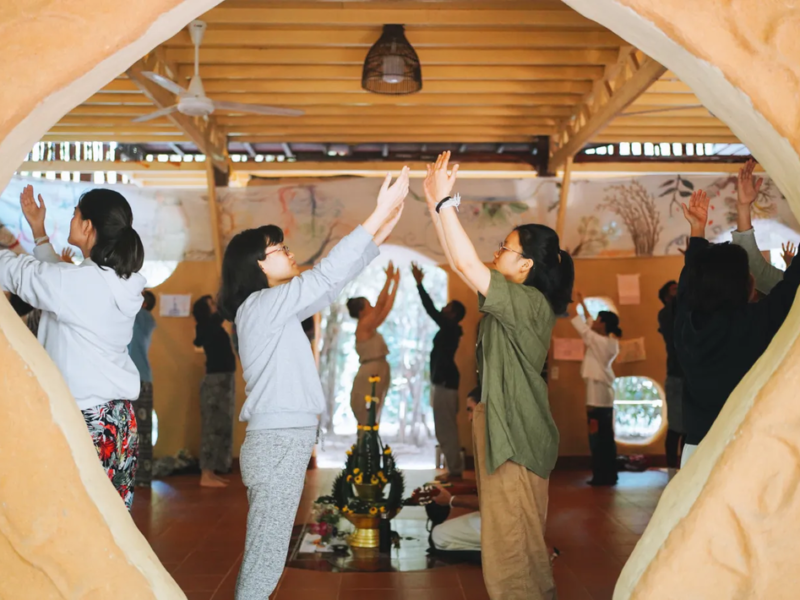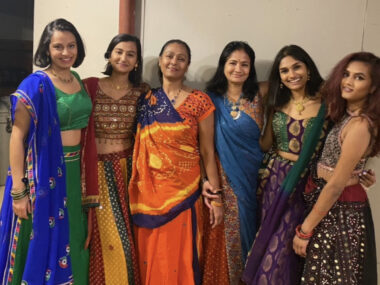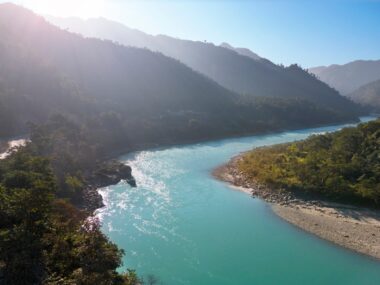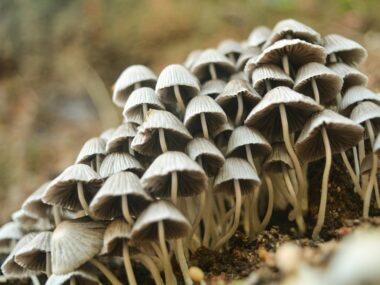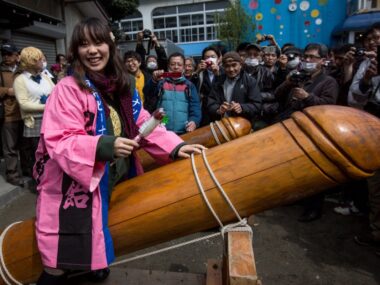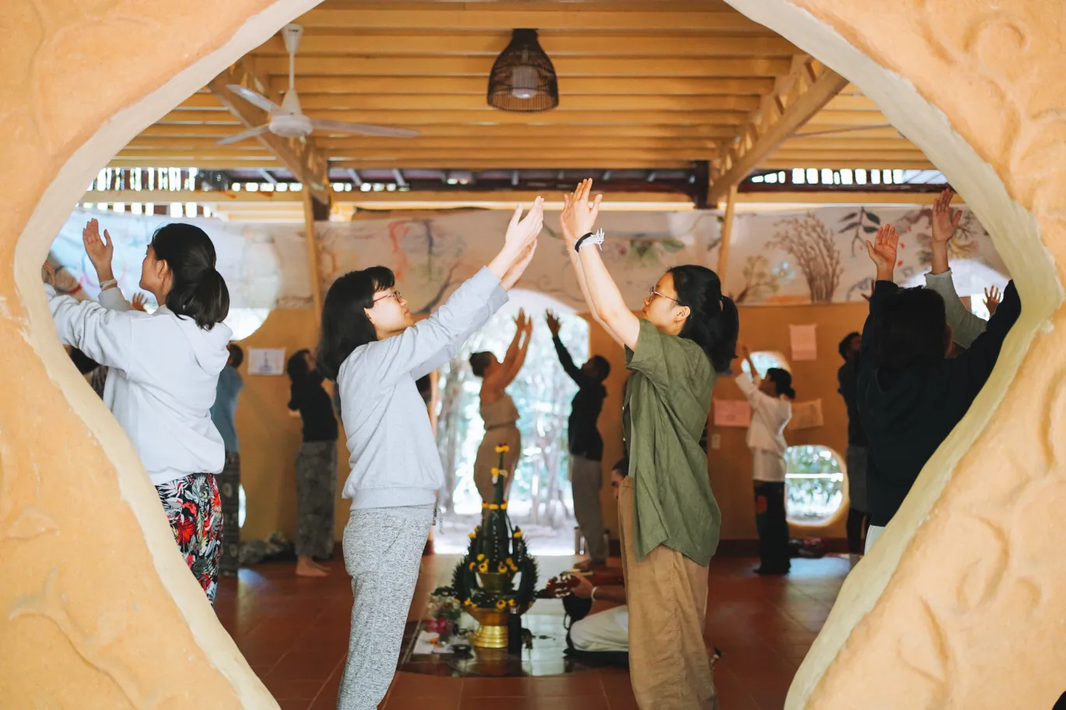
Table of Contents
14 years ago when I first started traveling, I volunteered at an eco-community for the first time – and I was hooked! From sustainable living hacks to nature connection to fast friendships with fellow volunteers, I loved community life and quickly made a habit of volunteering in eco-communities in many of the countries I visited. Eventually, I even pursued a master’s degree exploring the social dimension of sustainability in eco-communities.
My quest to understand social dynamics in communities led me to Thailand, where I visited a range of different communities. Below is the lowdown on the top three I recommend. Most of these are suitable for people who want to follow a volunteer schedule and get their hands dirty on the daily, but one of the communities below also accepts non-working guests and has high-speed wifi, making it ideal for digital nomads who want to get involved regularly but might not have fixed times during which they can volunteer daily.
Gaia Ashram
Gaia was one of the communities I visited during my thesis research. I found it online and was delighted to see that it was co-founded by Om Sunisa Jamwiset, my favorite facilitator from an Ecovillage Design Education course I’d attended in 2012. At the tail end of that course, Om met her partner Tom, and the two of them established Gaia on Om’s family’s land, had two adorable kids, and started hosting volunteers, guests, interns, and course participants from all around the world.
Above: Volunteers at Gaia celebrating after making lots of adobe bricks 🔥Image by Gaia Ashram.
I first visited Gaia with the aforementioned boyfriend from the ‘Sahainan’ section, except by that point we were just old friends. He’d come to visit me in Thailand to escape the German winter for a month, and we both fell in love with Gaia pretty quickly.
Tobias also fell in love with the yoga teacher, though, so he stayed behind, whereas I went to Chiang Mai. The yoga teacher ended up leaving him for another woman, but he stayed at Gaia anyway and ended up becoming a core part of the team and even building his own house. He later reported that Gaia had installed high-speed wifi, so in February of last year, I went back to visit him for a stay as a digital nomad guest for a short time…or so I thought. I stayed two and a half months, continue to return whenever I can, and excitedly talk about Gaia to nearly everyone I meet.
Below is an insider look into volunteering at Gaia. Before diving into that, note that it’s also possible to stay as a guest and make your own schedule or to join a course on Ecovillage design, permaculture, natural building, or another sustainability-oriented offering.
Volunteer Activities at Gaia Ashram
Volunteers at Gaia follow a weekly schedule that varies in accordance with the needs of Gaia at that time, and ensures that volunteers are exposed to a range of different tasks so that they can pick up many new skills. Usually, the activities involve a mix of permaculture gardening and farming, agroforestry, and natural building.
Daily Schedule
6:00: Meditation
6:30: Yoga and/or Tai Chi
7:30: Breakfast
8:45: Morning circle
9:15-12:00: Morning work session
12:30: Lunch, rest, and chore time
14:30-17:00: Afternoon work session (Wednesday afternoons are free)
17:30-18:30: Afternoon activity
19:00: Dinner
20:15: Evening activity
22:00: Quiet hours
If you’re wondering what ‘morning circle’ means, it’s a time when the community comes together to check in about how everyone’s feeling that day and briefly discuss anything that needs to be communicated, whether it’s what’s broken and needs fixing, what’s happening that day, or any volunteer questions, concerns, or wellbeing needs.
As for the afternoon and evening activities, these slots on the schedule are filled by anything visitors want to offer and organize. There have been ecstatic dances, game nights, nighttime swims, campfire nights, singing circles, cacao ceremonies, Thai herb spa nights, and plenty more.
Food at Gaia Ashram
Gaia’s live-in chef and gardener, Ladda, cooks 3 delicious Thai vegetarian meals per day, 5 days per week. On weekends, Gaians cook for themselves using whatever food is available in the kitchen and gardens, or visit eateries in the nearby villages.
Accommodation at Gaia Ashram
Volunteers usually stay in Gaia’s spacious dormitories, but there are also single rooms, double rooms, tents, and a family house with two bedrooms, its own shower, and a kitchenette area.
Leisure at Gaia Ashram
Since there are usually around 15-50 people at Gaia at any one time, the social environment is quite stimulating. People offer various activities to each other, go to local holiday celebrations at the nearby temples, swim in the pond, and visit nearby cities on the weekends.
Fees at Gaia Ashram
Volunteering at Gaia costs 400 baht per night for the dormitory or 550 for a single room. Check here for more details. Guests, on the other hand, pay 600 per night for a dormitory bed and 750 for a single room. All of these rates include food.
Digital Nomads at Gaia Ashram
Gaia is a great place for environmentally-minded digital nomads to stay as guests. While the community does want guests to contribute to the community, they offer flexibility – guests can follow their own schedules and join in when they can rather than following a more rigid volunteer schedule. There is also high-speed wifi in the single and double rooms where digital nomads would be likely to stay – and it (usually) works very well!
Gaia is nearby the Thailand/Laos border checkpoint closest to Laos’ capital city, so it’s a great place to visit for backpackers who are just coming from Laos or on their way there. It’s also located in Isan, which is a rural Thai region with its own distinct culture, and townsfolk who absolutely love a good party; go there to experience some truly authentic Thai culture far off the tourist trail. On the other hand, if you’d rather visit another well-known community that has the advantage of being just outside of Chiang Mai (a major city and tourist hotspot in northern Thailand), check out Pun Pun below.
Pun Pun Center for Self-Reliance
Pun Pun has been around since July 2003, which is longer than most other communities in Thailand. Since their mission is self-reliance, they do a lot of farming and natural building, but what they’re most famous for is their massive seed saving operation. Pun Pun is also unique in that it is a community with a larger long-term core group of around 20-25 people, in contrast to the others featured here, whose communities are largely made up of short, medium, and long-term volunteers and interns, with smaller core member groups.
During my stay in Pun Pun, I noticed that residents made a lot of references to ‘experimenting’ and Pun Pun and what they do there being an ‘experiment’ that I and the other volunteers were invited to join in on. I loved the humility and curiosity behind this sentiment.
Above: Volunteers and community members at Pun Pun. Image by Pun Pun. Taken from http://www.punpunthailand.org/index027d.html?page_id=34
Volunteer Activities at Pun Pun
Volunteers at Pun Pun typically get involved in a range of tasks, from sorting seeds for saving to cleaning to farming, gardening, making natural soap and other products, and cooking. Many people also visit Pun Pun to take courses.
Daily Schedule
9am-12pm: Morning work session
3pm-5:40pm: Afternoon work session
The schedule outside of these hours is not fixed and allows for a fair degree of freedom. Pun Pun volunteers must commit to a minimum of 2 weeks and a maximum of 2 months, although there might sometimes be opportunities to extend beyond two months.
Food at Pun Pun
Residents and volunteers cook vegetarian meals on a rotating shift schedule. I quite liked this arrangement, because it means that you get to try the cooking of many different people. Food is harvested from the farm, and some is bought locally.
Accommodation at Pun Pun
Accommodations at Pun Pun are quite basic mud buildings; most of the available accommodations were shared rooms of varying sizes. When I visited, the accommodation buildings were in a state of disrepair, but this may have been because I was in the first volunteer cohort to be welcomed after the COVID-19 pandemic, and so perhaps they hadn’t really had time to fix up the housing properly.
Leisure at Pun Pun
When I was at Pun Pun, it didn’t seem to have as active a social life for volunteers as Gaia Ashram and Sahainan did, but it may have been because I was in the first cohort to return after COVID, when things were still a bit wonky. Plus, if there’s one thing I’ve learned from visiting and living in community, it’s that the vibe at any given community changes so much based on who’s there and what’s going on at the time. By now, I’ve also seen Gaia through phases where the social life felt muted, and I think that’s what was happening at Pun Pun at that particular moment in time. To their credit, people did hang out frequently in the kitchen before and after meals, or in the cafe. And, our volunteer group didn’t bond so much, but had we had more in common, I’m sure we would have done more socializing. Around Pun Pun there’s also a cute village to visit and some beautiful places in nature to walk around.
Cost for Pun Pun
Volunteering at Pun Pun costs 500 baht per day for the first two weeks, 450 for days between 2-3 weeks, 400 per day for days betwen 3-4 weeks, 11,000 for a month, or 300 per day after the first month.
Sahainan
I first met Sandot, a smiley Thai farmer who gives that wisdom-of-the-ages energy, at his former eco-farm project (Tacomepai) in northern Thailand. The laid back, seriously-close-to-nature vibe of the place drew me in immediately, and I felt warmly embraced by northern Thailand’s beautiful jungle, the community of volunteers, and Sandot’s gentle nature.
Above: Sahainan folks sitting by the river and enjoying some home-cooked food. Image by Sahainan. Taken from www.sahainan.com.
This was an experience that truly embodied the concept of self-sufficiency. We slept in open-air bamboo structures. We cooked from what we found on the farm. We grew and harvested our own rice, even husking it by hand in the traditional way.
We even made our own coffee, harvesting the fruits, squeezing them open to reveal the bean, drying them, removing their skins, roasting the beans, grinding them, and finally boiling them into a coffee that tasted more flavorful for having been produced with the sweat and love of our labor.
A few years later, Sandot moved away, sold the land, and started a new farm with a similar vibe in an even more remote region of northeast Thailand. He named his new project ‘Sahainan’. ‘Sahai’ means ‘comrades’ or ‘companions’ in Thai, and ‘Nan’ is the name of the province where the farm is located. I went to visit in 2016, when Sahainan was in its early stages– but already Sandot had planted a smorgasboard of local fruits and veggies and established multiple structures on the land, built from bamboo and teak in a range of styles inspired by northern Thailand’s hill tribes.
While Sahainan was brand new back then, today it is a well-established and thriving farm and land regeneration and reforestation project, with delicious, organic fruits and vegetables growing all over the place and courses on offer as well as volunteering. Along the way, Sandot also married a wonderful like-minded woman who came to stay at the farm, and now they have a little boy who’s probably the luckiest kid on the planet to grow up in a place like Sahainan.
I stayed at Sahainan for about a month, took a permaculture design course there, and got involved in a range of volunteer activities. Here’s the lowdown on life at Sahainan as a volunteer.
Volunteer Activities at Sahainan
What stuck out to me about the time spent working and learning at Sahainan was the prominence of bamboo in daily life. We’d take our machetes and go out into the forest every few days to harvest bamboo and make things from it. We made bowls, cups, spoons, knives, and even forks from bamboo, and my boyfriend at the time and I took on a project making a whole entire square-shaped fenced enclosure from just bamboo and nails.
I’m not a very handy person when it comes to tools, but after working on that fence day in and day out for a week, I could confidently split each piece of bamboo, form it into flexible pieces, and weave them together around a couple of horizontal support pieces to make a real, solid, functional fence! This small accomplishment in itself felt like a major skill upgrade.
Aside from working with bamboo, volunteers can also get involved in:
- Cooking
- Harvesting
- Compost-making and maintenance
- Planting trees, fruits, herbs, vegetables, and rice
- Reforestation and greening of dry lands
- Dehusking rice
- Caring for saplings in the seed nursery
- Making natural soap
- Working in the rice fields and food forest
- Making/maintaining natural water filtration system
- Building furniture, houses, and other structures with bamboo, teak wood, and mud
- Community outreach and permaculture education
- Hanging out with kids
Daily Schedule
6:30: Harvesting, prepping breakfast, and any other tasks that need doing
7:30: Breakfast
8:30: Morning volunteer session
10:30: Lunch prep begins
12:00: Lunch and rest
16:00: Prepare dinner
5:30: Dinner and rest
One day per week is a free day; usually that’s Saturday. While volunteers are encouraged to join these activities, especially the morning volunteer work, they are not obligated. Sandot and his family really value personal freedom and individual preference, while also emphasizing the importance of ‘fair share’, one of the core permaculture ethics. So in other words, skip the work session if you really need a morning to yourself, but do your best to contribute fairly and equally to the community overall.
Food at Sahainan
Vegetarian meals are prepared over a fire, and volunteers eat using simple bamboo bowls and cutlery handmade onsite. Most of the food is harvested from Sahainan itself, while some comes from nearby farmers. Most importantly, it’s really, really tasty.
Accommodation at Sahainan
There are various structures for sleeping scattered around Sahainan, such that there’s usually an option for private accommodation. Most of the accommodations are simple open-air structures built in the various styles of the hill tribes in the area. Some have electricity and attached toilets; otherwise, there are always shared toilets and electricity nearby.
Leisure at Sahainan
Outside of working hours, volunteers entertain themselves by spending time together hanging out, chatting, and playing games, taking trips to the nearby town of Thung Chang, doing yoga in Sahainan’s large, beautiful yoga sala, meditating, enjoying nature, and playing with the local kids. Sometimes Sandot takes volunteers on adventures. For example, when I was there, we went to the jungle for a day to forage, trap fish, and weave bamboo baskets. Then, a local medicine man came and gave holistic body treatments to whomever wanted.
Cost for Sahainan
Short-term volunteers pay 4,000 baht for 10 nights or less and 400 baht per night after that. Visitors also have the opportunity to come as longer-term interns, taking on more responsibility and a more managerial role over time. This program costs 32,000 baht for 80 days, including a free 10-day practical permaculture course (normally 8,800 baht). After the 80 days are complete, interns are invited to stay as long as they want for free, as long as both sides are happy with the arrangement. There’s also another 80-day internship offer aimed exclusively towards carpentry.
I wholeheartedly recommend Sahainan for anyone who likes the off-grid, back-to-basics community vibe.
Have you visited any communities from this list, or others in Thailand? Tell us about your experience in the comments!

